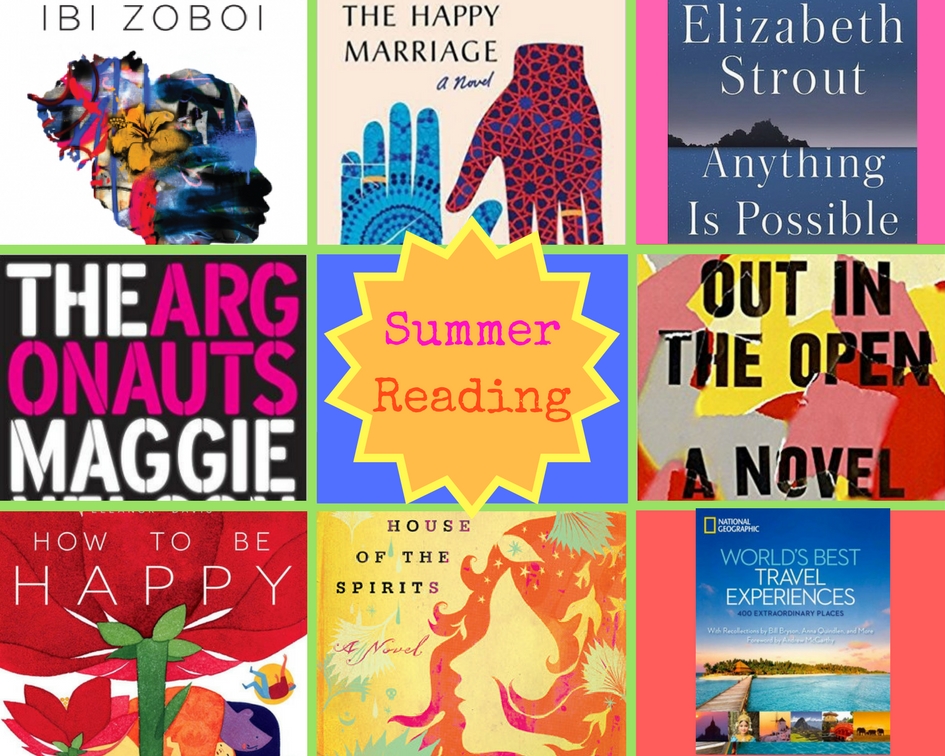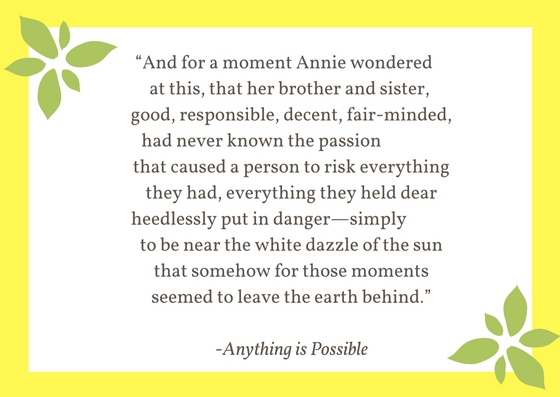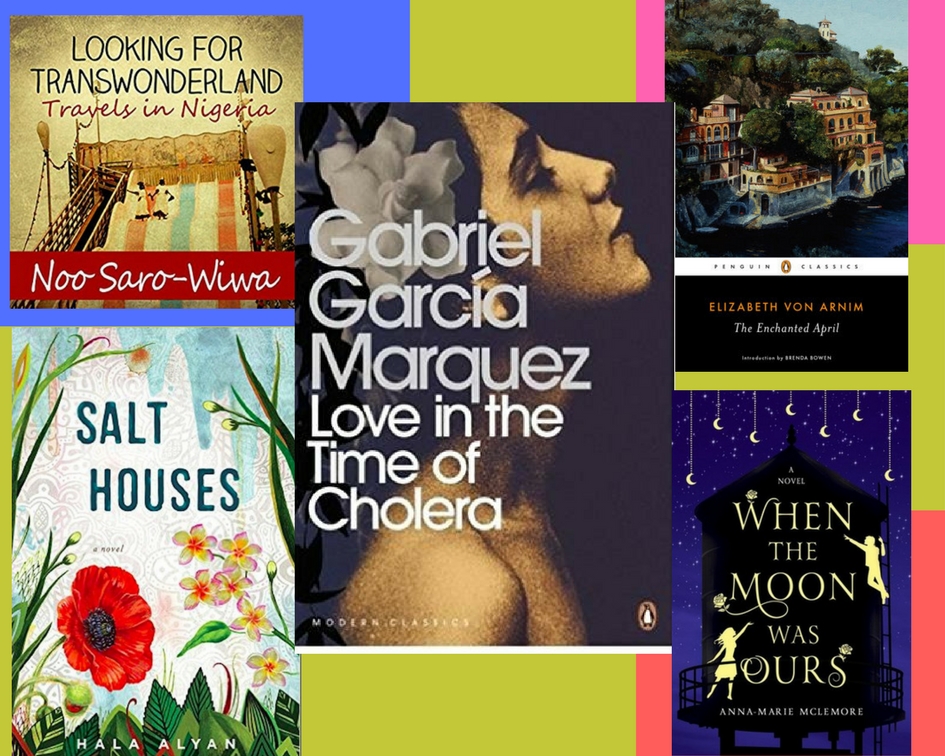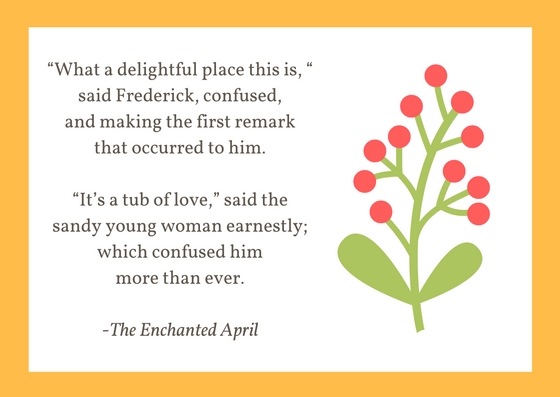June Staff Picks: Summer Reading!
posted: , by Elizabethtags: Library Collections | Adults | Teens | Seniors
Summer’s…here! We’ve got an exciting Adult Summer Reading Challenge this year. We’ve also prepped booklists of suggestions inspired by our Reading Challenge List to help you meet your goals. Find: YA Bestsellers, Dystopian Novels, Popular Authors’ First Books, Graphic Novels, Indie Press reads, Travel books, Short Stories, and Fiction in Translation. Our June Staff Picks draw from a few of these categories as well.
We hope you enjoy all your reading adventures this summer.
Popular YA
Harper’s Pick
If you want to push back against the boundaries of reality with your reading this summer, check out Stonewall Honor winning YA novel When the Moon Was Ours by Anna-Marie McLemore. Written in a magical realism style that reads similarly to works by Gabriel Garcia Marquez and Isabelle Allende, When the Moon Was Ours tells the story of Samir, an Italian-Pakistani trans boy, and Miel, a Latina girl who grows roses from her wrist. Full of powerful witch women, a forest full of moon lanterns, pumpkins that turn to glass, and magical clouds of butterflies, When the Moon Was Ours will make you think about the ways you look at gender, family, identity, community, and love.
Nonfiction
Jim’s Pick
On Trails by Robert Moor is great travel pick: it’s a nonfiction book on the nature of how trails are made through history, and how some are continuing to be used after thousands of years while others have to be rediscovered. Moor hits the trail in Morocco, Alabama, Newfoundland, Arizona, North Carolina, recording his adventures along the way…a perfect summer book to ready yourself for hiking.
Nate’s Pick
My Summer Reading June Staff Pick is Looking for Transwonderland, the first book by Noo Saro-Wiwa. Saro-Wiwa is an essayist and critic who has written for the Times Literary Supplement, the Financial Times, and The Guardian. She’s also the daughter of noted Nigerian author and activist Ken Saro-Wiwa. Before being executed in Nigeria in 1995 by the regime of Sani Abacha, Ken Saro-Wiwa was a leader of the Ogoni people, whose traditional homelands lie in the Niger River Delta, a major source of Nigeria’s oil wealth. He was outspoken in his critique of the Nigerian government and the environmental degradation that resulted from oil extraction by multinational corporations.
Looking for Transwonderland chronicles Noo Saro-Wiwa’s return to Nigeria many years after her father’s death. Raised in the UK, Noo Saro-Wiwa returns to a rapidly changing Nigeria and spends time navigating historical cities such as Lagos and Port Harcourt as well as the newly constructed capital of Abuja. Noo Saro-Wiwa includes multiple reflections on childhood experiences in Nigeria, often remembering her father, his dedication to the idea of a whole Nigeria, and their excursions together. As an avid reader of travelogues, I was drawn to Looking for Transwonderland for its exploration of a truly fascinating country, as well as its literary linkage to Ken Saro-Wiwa.
Fiction
Brandie’s Pick
I read and loved My Name is Lucy Barton last year (I’ve actually loved everything by Elizabeth Strout, I’m a big fan, but who doesn’t love Elizabeth Stout?). So when I heard about her new collection of short stories based on the characters from that book, Anything is Possible, I was thrilled to be first in the hold line. Strout said, “As I was writing My Name Is Lucy Barton it came to me that all the characters Lucy and her mother talked about had their own stories—of course!—and so the unfolding of their lives became tremendously important to me.” How many times does this happen in a book, where you want to know more about the peripheral characters but never get that opportunity? Well, here you go! It’s a perfect read for the beach and the short stories, I am sorry to say, go by as quickly as a Maine summer.
Sarah’s Pick
As temperatures climb and days turn lazy and hazy, I find myself drawn back to the steamy, sleepy magic of Love in the Time of Cholera by Gabriel Garcia Marquez. I could read this book over and over every summer for the rest of my life and never tire of it. This tale of bittersweet romance, drawn out over the course of a lifetime, is set somewhere near the Caribbean Sea, sometime around the turn of the twentieth century. The depth of the story’s characters and the intensity of their emotions make it seem almost real, yet something about the disjointed timeline and the too-vivid colors of birds and flowers makes you wonder if you’ve drifted off to sleep on a distant shore and started to dream this sentimental, passionate, lovesick story of blossom and decay. And then you float away to the somewhere and the sometime and get lost in the tale.
BONUS: This book fits into two of the categories on our Adult Summer Reading Challenge! The original Spanish text has been translated into English, and it is available in eAudiobook format from cloudLibrary.
Elizabeth’s Picks
If you have ever felt a bit geeky and out of place, you may sympathetically enjoy the ruminations of Selin, the semi-hapless college student who narrates Elif Batuman’s first novel, The Idiot. Batuman’s book fits in with our summer reading travel category—at least in the second half of the book when Selin journeys to Hungary to teach English, and comic encounters ensue. (She visits France and her relatives in Turkey, too). Selin is not perfect, which will probably annoy some readers. Instead, she’s perplexed: by language, literature, love, other people, email (it’s 1995). If you’re looking for a thrilling, suspenseful plot, this isn’t for you! Read The Idiot if you have an unflagging interest in the weirdness of individual brains, swooping bike rides in the Hungarian moonlight, and writing rich with the meandering, zany pains and pleasures of one year in a life observed.
Salt Houses by Hala Alyan is a fantastic first novel, lyrical, both radiant and haunted, illuminating the complexities of the Yacoub family: Alia, Atef, their children and their grandchildren—Salt Houses passes through generations. There are so many stories here: stories of what is lost and found, of searching for home, of nostalgia for the past as the family is uprooted again and again because of war. From Jaffa, from Nablus, from Kuwait City. To Paris, Beirut, Boston, Amman. Alyan’s writing is memorable, lively, lush, as chapters switch between characters and we drop deeply into each different point of view. Karam carves a bird for his beloved sister, and paints it a vivid blue, her favorite color. Alia forgets the word for pomegranate, and so her fate is sealed. Riham nearly drowns, and is saved. Atef writes undeliverable letters to his best friend, who was killed. On his daughter’s birthday, Atef muses: “How tiny our lives are, he thinks, swelling to impossible size with love, then shrinking again.” Salt Houses is a good example of how the best books expand our own lives, too.
Eileen M’s Pick
The Enchanted April, by Elizabeth Von Arnim
94 years ago. Good heavens. That’s when my earnestly proffered summer read was first published. 1923 it was when its new binding, whose board corners now are rounded and signatures compromised, was cracked for the first time by a gentle reader who, just one paragraph into the book, read this advert at the same instant that main character Lotty Wilkins did:
To Those who Appreciate Wistaria and Sunshine. Small mediaeval Italian Castle on the shores of the Mediterranean to be Let Furnished for the month of April. Necessary servants remain. Z., Box 1000, The Times.
And so the story launches from its rainy, grey London beginnings, taking dear Lotty, a collection of new acquaintances and some familiar but soon-to-be freshly experienced companions, and us if we are wise enough to join them, on a month-long sojourn out of our ruts and deep into our hearts, bathed in Italy’s April sunshine the while.
The sandy young woman is Lotty. I love Lotty. How could I not?
I read this in March, when the wind was howling and the word “snow” was very much an active present tense verb as well as an endlessly wearisome noun, when Spring seemed such a godawful long way off that I was desperate for deliverance. The Enchanted April was salvation in a compact volume which I eagerly devoured as winter pressed on and on. And even as I ate up the prose, huddled in front of the wood stove and grateful for its heat, I could see myself doing similar in a vastly different meteorological milieu: perched, perhaps, in an adirondack chair, lazily brushing an easily discouraged lady bug or two from the open pages before me; the only sweat in sight forming on my tall tinkling-iced tumbler of sweet tea. I was pretty sure it could happen in June, or maybe July, certainly August. This would be the book I would go to when my brain didn’t want to work too hard for too long. When I was hungry for something that would transport me, would forgive me dozing off, sunglasses askew; would provide just the right measure of surefire pleasure with its combination of old-timey phraseology and frail human feelings that are, it turns out, brave and timeless.
And lo! It is June and I find myself with a week off from a job that I enjoy but am content now to keep at an unaccustomed distance. True, I am more likely to be garbed in bug-netting than in the fine-woven linen shift I may have envisioned in my March reverie. Ladybugs will be cowering under cover as I swat away black flies and mosquitoes and spritz myself with deet. But I have that same battered copy of The Enchanted April in hand, ready to feel good all over again, this time with a view burgeoning like a San Salvatore spring in place of the cold white unpromising scene that drove me to this lovely story to begin with. Let’s get this show on the road!
But wait! There’s more! I have no shame and I want you to benefit from my lack: if you can’t summon enough summertime energy to follow words on a page, sentences in a paragraph… do not despair. By all means check out the 1991 movie based on this book. Its perfection of a cast, scenery obliging the most world-weary among us to sigh a sigh of monumental relief, and habiliments that will make you pine for a time when the flow of a kimono or the soft drape of a chemise could tell a story all on its own… let this film’s considerable magic toss its story-net over you without having to read a word. If you can’t live with the guilt of such effortless enjoyment, engage the closed captioning and read along.
Either way you can’t lose. You are bound for San Salvatore.







